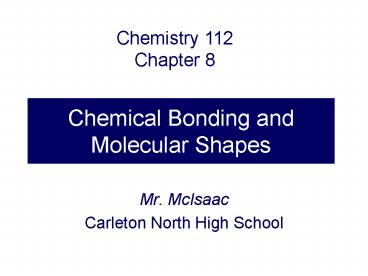Chemical Bonding and Molecular Shapes - PowerPoint PPT Presentation
1 / 11
Title:
Chemical Bonding and Molecular Shapes
Description:
Chemistry 112 Chapter 8 Chemical Bonding and Molecular Shapes Mr. McIsaac Carleton North High School Electron Arrangement (Energy Levels, Sublevels, Orbitals ... – PowerPoint PPT presentation
Number of Views:128
Avg rating:3.0/5.0
Title: Chemical Bonding and Molecular Shapes
1
Chemical Bonding and Molecular Shapes
Chemistry 112Chapter 8
- Mr. McIsaac
- Carleton North High School
2
Electron Arrangement(Energy Levels, Sublevels,
Orbitals)
- Electrons travel around the nucleus at certain
distances, called energy levels. - Inside each energy level, there are sublevels
the number of sublevels is equal the number of
the energy level - 1st energy level has 1 sublevel (s)
- 2nd energy level has 2 sublevels (s, p)
- 3rd energy level has 3 sublevels (s, p, d)
- 4th energy level has 4 sublevels (s, p, d, f)
- 5th energy level has 5 sublevels (s, p, d, f, g)
3
Electron Arrangement (cont.)
- Inside each sublevel, there are orbitals
specific regions/areas inside the e cloud where
individual es exist. - An orbital may be empty, or may hold 1 or 2 es.
Any orbital can hold a maximum of 2 es. - An outer level (valence level) can hold a maximum
of 8 es. So, an outer level has a maximum of 4
orbitals.
4
Electron Arrangement (cont.)
- Stated another way, an outer level has a maximum
of 2 sublevels (s, p). - An s sublevel has 1 orbital a p sublevel has 3
orbitals. Total 4 orbitals 8 es (2 per
orbital). - Valence electrons exist in these outer 4 orbitals.
5
Filling The Outer Level
- As bonded elements
- The first 4 es (1, 2, 3, 4) will
singly/separately occupy each of the outer 4
orbitals the 1st in the s orbital, and 2nd,
3rd, 4th in each of the 3 p orbitals. - The next 4 es (5, 6, 7, 8) will pair up in each
of the outer orbitals the s, and then the 3 p
orbitals.
- As unbonded elements (FYI we dont worry about
it) - The first 2 es (1 and 2) will fill the s orbital
- The next 3 es (3, 4, 5) will singly/separately
occupy each of the 3 p orbitals. - The next 3 es (6, 7, 8) will pair up in each of
the 3 p orbitals.
6
Lewis Electron Dot Diagrams
- In a Lewis Electron Dot Diagram for an element,
the symbol of the element represents the nucleus
and all the inner electrons, and the 4 sides
around the symbol represents the 4 valence
orbitals.
- Each of the above dot diagrams is equivalent
any of the 4 sides is the same
7
Lewis Electron Dot Diagrams
- Electrons like to exist in pairs, and single es
bond/share with single es from other atoms. - When two atoms share a pair of es, it is called
a bonded pair, shared pair, or covalent bond.
- Notice that when showing dot diagrams for
different elements forming a compound, it is
common to use dots for one element and xs for
the other it just makes it easier to follow.
8
VSEPR TheoryAnd Predicting Molecular Shapes
- Valence Shell Electron Pair Repulsion (VSEPR)
theory is the understanding that pairs of es
will repel each other and move as far apart from
each other as possible. - Predicting molecular shapes and bond angles can
be done by drawing dot diagrams showing the pairs
of es (shared and unshared) around a central
atom.
9
5 Molecular ShapesFromSingle Bonds
10
Double and Triple Bonds
- Adjacent atoms can share more than one pair of
electrons. - Try O2, N2, CH2O, CHP
11
Summary Predicting Molecular Shapes
- Draw the Lewis Dot Diagram for the molecule to
determine the number of bonding and non-bonding
electron pairs. - Make sure all atoms are present.
- Cannot have any single es (dots/xs) left.
- Only adjacent atoms can bond.
- Es/dots from same atom cannot pair up.
- When determining the shape of a molecule with
multiple bonds, treat the multiple bonds as if
they were single bonds (i.e. one bonding side or
direction)

